Adam Mickiewicz University in Poznań
University of Würzburg
Class. Armenian, intro, unit 1
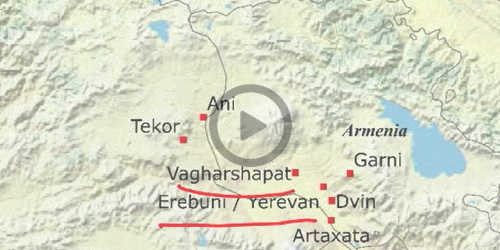
DOI: https://doi.org/10.5446/48959
external history of Armenian; periods: Old, Middle, Modern Armenian; sources and dates, Armenian alphabet and earlier writing
slidesClass. Armenian, sounds, unit 1
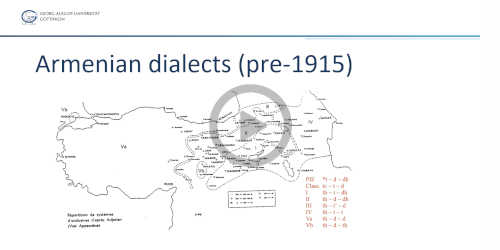
DOI: https://doi.org/10.5446/48956
segments: consonants, stops and affricates (including dialectal contrasts), consonant alternations
slidesClass. Armenian, words, unit 1
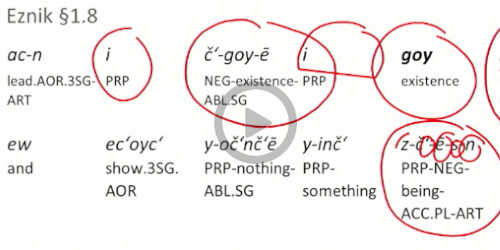
DOI: https://doi.org/10.5446/48953
word formation: morphological devices (pre-, suffixing, reduplication, etc.), composition
slidesClass. Armenian, structures, unit 1
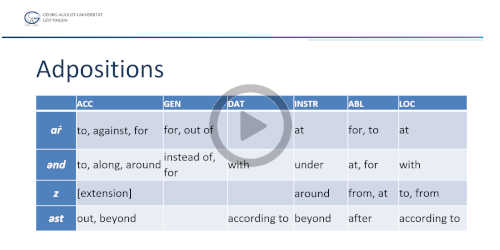
DOI: https://doi.org/10.5446/48948
basic syntactic features, complex NPs, case attraction, definiteness, adpositional structures
slidesClass. Armenian, structures, unit 2
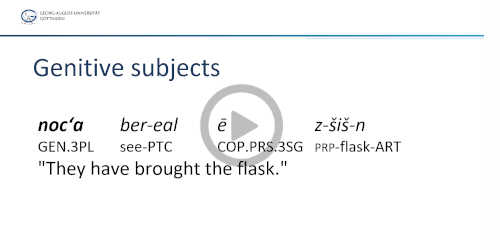
DOI: https://doi.org/10.5446/48947
predication, grammatical/semantic roles, valency increasing and decreasing operations
slidesselection out of the lecturers’ references, enriched by Paulien Veenstra and project members:
general introductions, encyclopedias, literature, writing, history, miscellaneous
Gippert, Jost. 2005. Das Armenische - eine indogermanische Sprache im kaukasischen Areal. In Meiser, Gerhard & Hackstein, Olav (eds.), Sprachkontakt und Sprachwandel. Akten der XI. Fachtagung der Indogermanischen Gesellschaft, 17.-23. September 2000, Halle an der Saale. Wiesbaden: Reichert. 139–160.
Harutyunyan, Khachik. 2019. Brief introduction to Classical Armenian also known as Grabar. Magaghat. (Accessed 2021-06-29.)
Martirosyan, Hrach K. 2013. The place of Armenian in the Indo-European language family: The relationship with Greek and Indo-Iranian. Journal of Language Relationship/Вопросы язкового родсмба 10. 85–138.
Vidal-Goréne, Chahan & Decours-Perez, Aliénor. 2020. Languages Resources for Poorly Endowed Languages: The Case Study of Classical Armenian. Proceedings of the 12th Language Resources and Evaluation Conference. 3145–3152.
grammars, treatments of major grammatical domains
Djahukian, Geworg B. [Джаукян, Г. Б.]. 1982. Сравнимельная грамматика армянского языка [Comparative Grammar of Armenia]. Ереван: Издательство АН Армянской ССР.
Godel, Robert. 1975. An Introduction to the study of Classical Armenian. Wiesbaden; Dr. Ludwig Reichert Verlag.
Jensen, Hans (1959). Altarmenische Grammatik. Wiesbaden: Carl Winter Universitätsverlag.
Jungmann, Paul & Weitenberg, Joseph. J. 1993. A Reverse Analytical Dictionary of Classical Armenian (Trends in Linguistic Documentation 9). Berlin: Mounton de Gruyter.
Meillet, Antione. 1903. Esquisse d'une grammaire comparée de l'arménien classique. Vienna: Imprimerie des PP. Mékhitharistes.
dictionaries, headword search tools, further sources of information about the lexicon
Acharian, Hrachia. 1971. Հայերեն արմատական բառարան [Dictionary of Armenian Root Words]. 4 Vols. Yerevan: Yerevan State University.
Djahukian, Guevorg. 2010. Հայերեն ստուգաբանական բառարան [Armenian Etymological Dictionary]. Yerevan: International Linguistic Academy.
Jensen, Hans (ed.). 1964. Altarmenische Chrestomathie, mit einem Glossar (Indogermanische Bibliothek, Vol. 1). Heidelberg: Carl Winter Universitaetsverlag.
Martirosyan, Hrach K. 2010. Etymological dictionary of the Armenian inherited lexicon. Leiden: Brill.
Vidal-Goréne, Chahan. Enriched Dictionaries of Classical and Modern Armenian. Calfa. (Accessed 2021-06-29.)
text collections, corpora, treebanks
Garsoian, Nina G. 1989. The Epic Histories Attributed to Pawstos Buzand (Buzandaran Patmut'iwnk) (Harvard Armenian Texts and Studies 8). Cambridge, Mass.: Harvard University Press.
Gippert, Jost & Martinez, Javier & Korn, Agnes. TITUS TEXTUS (Text Database). TITUS: Thesaurus Indogermanischer Text- und Sprachmaterialien. (Accessed 2021-06-29.)
Greenwood, Timothy. 2004. A corpus of Early Medieval Armenian inscriptions. Dumbartion Oaks Papers 58, 27-91.
Jensen, Hans (ed.). 1964. Altarmenische Chrestomathie, mit einem Glossar (Indogermanische Bibliothek, Vol. 1). Heidelberg: Carl Winter Universitaetsverlag.
See also Classical Armenian Texts in the PROIEL Treebank (ed. by Dag T. T. Haug and Marius L. Jøhndal).
coursebooks, exercises, materials or introductions supporting teaching
Krause, Todd B. & Slocum, Jonathan. 2004. Early Indo-European Online: Classical Armenian Online. University of Texas: Linguistics Research Centre. (Accessed 2021-06-29.)
Thomson, Robert W. 1989. An Introduction to Classical Armenian. Caravan Books.